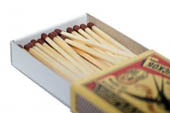
Purpose
To demonstrate how string instruments work by building our very own miniature guitar from a matchbox.
Additional information
Traditional guitars are played acoustically, where the sound produced is a result of the vibration of the strings and modulated by a hollow body. Electric guitars produce an electronically manipulated tone when played through amplifiers. As the guitar strings are plucked, the guitar pickup senses the vibrations from the strings and sends along an electronic signal to the amplifier. The amp reads the signal and converts it into an adjustable audible sound by boosting it through a speaker system.
Traditionally, guitar strings were made from cat intestines. These days strings are made from nylon, horse hair, bronze, and steel.
Sponsored Links
Required materials
- Empty matchbox
- 4 small rubber bands
- Balsa wood (very soft and light wood with a coarse open grain, suitable for carving)
- Craft knife
Estimated Experiment Time
About 15 to 30 minutes
Step-By-Step Procedure
- 1. Cut the piece of balsa wood into a flat triangular shape so that its length is a little longer than the width of the matchbox.
- 2. Place the triangle across the width of the matchbox so that the pointed end is hanging over. You don't need the piece that is hanging over, so cut it off. You now have what is called the "bridge".
- 3. Lay the bridge on the closed matchbox. Open the matchbox so it's about three-fourths open.
- 4. Put the rubber bands over the matchbox lengthwise and space them evenly. Make sure the rubber bands are tight. This can be done by opening the matchbox a little more.
- 5. Raise your bridge so that it stands up. Play your guitar!
Note
If you're having trouble getting the bands to fit tightly around the matchbox, smaller rubber bands may need to be used. Also, if you find your bands slipping off the bridge, you can create small grooves on the edge of the bridge where the rubber bands can rest. Refer to illustration for a basic idea on what your matchbox guitar should look like.
Observation
What else could you have used in this experiment to create a more varied sound on your matchbox guitar? Do you think you can use some of the principles you've learned here to create a bowed string (violin, cello, etc) instrument out of some common household items?
Result
The matchbox guitar is an example of a plucked string instrument, which also includes mandolins, balalaikas, and bass guitars. The instrument works by plucking the string with your finger tips. The different pitches are created by placing your finger at different points along the string to either shorten the pitch or lengthen it based on the vibration. The strength at which the strings are plucked also affects the frequency and pitch of the sound as it can create a larger vibration or a smaller vibration.
Sponsored Links
Take a moment to visit our table of Periodic Elements page where you can get an in-depth view of all the elements,
complete with the industry first side-by-side element comparisons!